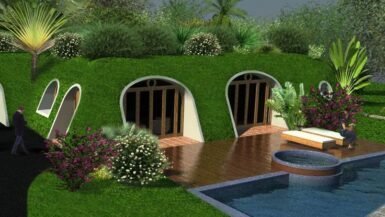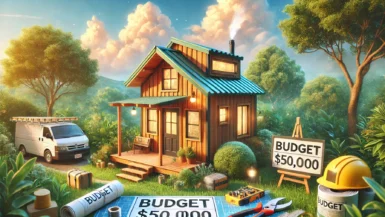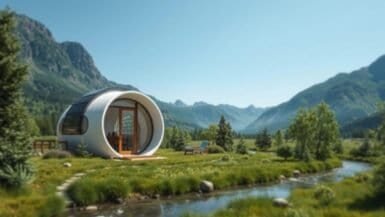As our society continues to evolve and prioritize sustainable living, the concept of tiny homes has emerged as a popular eco-friendly housing alternative. In this article, we will delve into the unique advantages offered by building a tiny home on wheels, a subcategory that fuses minimalist living with the functionality of mobility. We will explore the environmental benefits, financial savings, design flexibility, and the potential for a more fulfilling lifestyle that can be achieved through embracing this innovative housing solution. Join us as we uncover the various ways in which a tiny home on wheels can contribute to a greener future and inspire a reevaluation of our current housing norms.
Maximizing Space Efficiency: Design Tips for Tiny Homes on Wheels
Designing a tiny home on wheels requires a thoughtful approach to space utilization, ensuring that every square foot is used efficiently and effectively. With a focus on functionality, versatility, and aesthetics, you can create a comfortable and sustainable living space that doesn’t compromise on style or modern amenities. In this section, we’ll explore a variety of design tips that can help you make the most of your mobile tiny home.
Opt for Multi-Functional Furniture
One of the keys to maximizing space in a tiny home on wheels is incorporating multi-functional furniture. This may include a fold-out bed that doubles as a couch, a dining table that can be stowed away when not in use, or a desk that can also function as a storage unit. By selecting furniture with multiple uses, you can reduce clutter and ensure that your living space remains clean and organized.
Embrace Vertical Space
In a tiny home, vertical space is just as important as horizontal space. Utilize the height of your walls with floor-to-ceiling shelving, hanging storage, and wall-mounted appliances. This will help you to maximize storage options and free up valuable floor space for other uses.
Choose Built-In Storage Solutions
Built-in storage solutions are a great way to save space in a tiny home on wheels. Consider incorporating cabinetry, shelving, and storage compartments into the walls, floors, and even ceilings of your home. This will ensure that your belongings are stored neatly and efficiently, while also maintaining a streamlined and clutter-free aesthetic.
Invest in Space-Saving Appliances
When it comes to appliances, smaller is often better in a tiny home. Choose compact and energy-efficient appliances, such as a mini fridge, two-burner stove, or a combination washer-dryer unit. This will not only save space but also reduce your energy consumption, contributing to a more sustainable lifestyle.
Maximize Natural Light and Ventilation
A well-lit and well-ventilated space can make even the smallest living area feel more spacious and inviting. Incorporate large windows, skylights, or sliding glass doors to allow natural light to flood your tiny home on wheels. Additionally, opt for windows that can be opened to encourage cross-ventilation, helping to regulate the temperature and air quality within your living space.
By carefully considering the design and layout of your tiny home on wheels, you can create a space that is both functional and aesthetically pleasing. Through the incorporation of multi-functional furniture, vertical storage, built-in solutions, space-saving appliances, and ample natural light, you’ll be well on your way to embracing a sustainable and minimalist lifestyle.
Renewable Energy Integration: Solar and Wind Solutions for Mobile Tiny Homes
Incorporating renewable energy sources into a tiny home on wheels not only promotes sustainable living but also enhances the flexibility of living off-grid or in remote locations. By harnessing clean and renewable energy such as solar and wind power, you can reduce your carbon footprint, decrease your reliance on traditional energy sources, and minimize your energy bills. In this subsection, we will explore various solar and wind energy solutions that can be integrated into your mobile tiny home to help you achieve a more eco-friendly lifestyle.
Embracing Solar Power for Your Tiny Home on Wheels
Solar power is a popular choice for renewable energy integration in tiny homes on wheels. By installing photovoltaic (PV) solar panels on the roof of your mobile home, you can generate clean and sustainable electricity to power your appliances and devices. There are several options to consider when choosing a solar power system for your tiny home:
1. Fixed solar panels: These panels are permanently mounted to the roof of your tiny home and remain in a fixed position. They are a more affordable option but may not provide optimal solar exposure throughout the day.
2. Adjustable solar panels: These panels can be manually adjusted to maximize sun exposure and energy production. While they may be more expensive, they can increase the efficiency of your solar power system.
3. Portable solar panels: These panels can be easily moved and positioned to capture the most sunlight. They are ideal for tiny homes on wheels that frequently change locations, allowing for optimal solar exposure regardless of your parking spot.
In addition to solar panels, you will need a solar charge controller, an inverter, and a battery bank to store the generated electricity. These components must be carefully selected to ensure compatibility and efficiency, providing you with a reliable solar power system for your mobile tiny home.
Utilizing Wind Power for Your Mobile Tiny Home
Wind power is another viable option for generating renewable energy in your tiny home on wheels, particularly in areas with consistent and strong winds. By installing a small wind turbine on your mobile home, you can harness the power of the wind to produce clean electricity. Here are some factors to consider when choosing a wind turbine for your tiny home:
1. Size and capacity: The size and capacity of a wind turbine will determine the amount of electricity it can produce. Choose a turbine that is suitable for your energy needs and space constraints.
2. Location and wind speed: The efficiency of a wind turbine is directly influenced by its location and the average wind speed in the area. Research the wind patterns in your region and select a turbine that is designed for the specific wind conditions you will encounter.
3. Mounting options: You will need to decide whether to mount the wind turbine on the roof of your tiny home or use a freestanding pole. Both options have their pros and cons, so carefully consider the available space and structural requirements before making a decision.
Combining solar and wind power can create a hybrid renewable energy system that offers greater reliability and independence for your tiny home on wheels. By embracing these clean and sustainable energy sources, you are not only contributing to a greener future but also experiencing the freedom and autonomy that comes with living off the grid.
Water Conservation Techniques for Sustainable Tiny Homes on Wheels
In addition to energy efficiency, water conservation is a critical aspect of sustainable living in a tiny home on wheels. By adopting water-saving techniques and utilizing eco-friendly systems, you can significantly reduce your water consumption, minimize your environmental impact, and potentially lower your water bills. In this subsection, we will explore various water conservation techniques that can be easily integrated into your mobile tiny home, allowing you to enjoy a more sustainable and eco-conscious lifestyle.
Install Water-Saving Fixtures and Appliances
One of the simplest ways to conserve water in your tiny home on wheels is by choosing water-saving fixtures and appliances. Opt for low-flow showerheads, faucets, and toilets, as well as water-efficient appliances such as dishwashers and washing machines. These fixtures and appliances are designed to use less water without compromising their functionality, ensuring that you can conserve water without sacrificing comfort and convenience.
Implement a Greywater Recycling System
Greywater is the used water from sinks, showers, and washing machines, which can be treated and recycled for non-potable uses such as toilet flushing, irrigation, or even laundry. By implementing a greywater recycling system in your mobile tiny home, you can significantly reduce your fresh water consumption, decrease your reliance on municipal water supplies, and contribute to a more sustainable water cycle.
Collect Rainwater for Non-Potable Uses
Rainwater harvesting is another effective water conservation technique that can be easily incorporated into your tiny home on wheels. By installing a rainwater collection system, you can capture and store rainwater for non-potable uses such as irrigation, toilet flushing, or even laundry. This not only reduces your demand for fresh water but also mitigates stormwater runoff, which can help to prevent soil erosion and protect local waterways.
Practice Mindful Water Usage Habits
Water conservation in a tiny home on wheels also requires a conscious effort to adopt water-saving habits in your daily routines. Simple actions such as turning off the faucet while brushing your teeth, taking shorter showers, and only running full loads in your dishwasher and washing machine can significantly reduce your water consumption. By being mindful of your water usage and making small adjustments to your habits, you can contribute to a more sustainable lifestyle.
Integrate Drought-Tolerant Landscaping
If your tiny home on wheels includes an outdoor living space or garden, consider integrating drought-tolerant landscaping to further conserve water. This may involve selecting native plants that are well-adapted to the local climate and require minimal irrigation, as well as utilizing mulch and other water-saving gardening techniques. By embracing drought-tolerant landscaping, you can create a beautiful and sustainable outdoor space that thrives with minimal water input.
Incorporating water conservation techniques into your tiny home on wheels is an essential step towards embracing a more sustainable and eco-friendly lifestyle. By installing water-saving fixtures and appliances, implementing greywater recycling and rainwater harvesting systems, practicing mindful water usage habits, and integrating drought-tolerant landscaping, you can significantly reduce your water consumption and contribute to a greener future.
Eco-Friendly Materials: Choosing Sustainable Building Supplies for Your Tiny Home on Wheels
Constructing your tiny home on wheels with eco-friendly materials is not only beneficial for the environment but also crucial for creating a healthy and sustainable living space. In this subsection, we will explore various sustainable building materials that can be used to construct your mobile tiny home, as well as the advantages they offer in terms of energy efficiency, indoor air quality, and overall environmental impact. By carefully selecting these materials, you can ensure that your tiny home on wheels is built with the planet in mind while also providing a safe and comfortable living environment for you and your family.
Reclaimed and Recycled Materials
One of the most sustainable ways to source building materials for your tiny home on wheels is by using reclaimed or recycled materials. This may include salvaged lumber, reclaimed bricks, or recycled metal. By repurposing these materials, you can significantly reduce the environmental impact associated with the extraction, processing, and transportation of new building materials. Additionally, reclaimed and recycled materials often have unique textures and character that can add charm and personality to your tiny home.
Insulation Options for Energy Efficiency
Proper insulation is vital for maintaining a comfortable temperature within your tiny home on wheels and reducing your energy consumption. There are several eco-friendly insulation options available, including cellulose derived from recycled newspaper, sheep’s wool, and cork. These materials are not only sustainable and renewable, but they also provide excellent thermal performance, ensuring that your tiny home stays warm in the winter and cool in the summer.
Low-VOC Paints and Finishes
Indoor air quality is an important aspect of sustainable living, and choosing low-VOC (volatile organic compound) paints and finishes can significantly improve the air quality within your tiny home on wheels. Traditional paints and finishes often release harmful chemicals into the air, which can cause respiratory issues and contribute to air pollution. Opting for low-VOC alternatives ensures that your living space remains healthy and free from harmful pollutants.
Natural and Renewable Flooring Options
Flooring is another essential component of your tiny home on wheels, and selecting sustainable options can further enhance the eco-friendliness of your living space. Some popular natural and renewable flooring materials include bamboo, cork, and linoleum made from linseed oil. These materials are not only environmentally friendly, but they are also durable, easy to maintain, and attractive, making them an excellent choice for your tiny home.
Sustainably Sourced Wood
When choosing wood for your tiny home on wheels, it’s essential to select sustainably sourced options. Look for wood products that are certified by organizations such as the Forest Stewardship Council (FSC) or the Programme for the Endorsement of Forest Certification (PEFC). These certifications ensure that the wood has been sourced from responsibly managed forests, promoting the conservation of natural resources and the protection of biodiversity.
By incorporating sustainable building materials into your tiny home on wheels, you are not only contributing to a greener future but also creating a healthy and comfortable living environment for yourself and your loved ones. From reclaimed and recycled materials to eco-friendly insulation, low-VOC paints, natural flooring options, and sustainably sourced wood, there are numerous ways to make your mobile tiny home a true example of sustainable living.
Mobile Gardening: Growing Your Own Food in a Tiny Home on Wheels
The notion of growing your own food may seem challenging in a tiny home on wheels, but with a little creativity and resourcefulness, it is entirely possible to cultivate a thriving garden in a small mobile space. In this subsection, we will explore various mobile gardening techniques and tips that can help you produce fresh, homegrown food in your tiny home on wheels, contributing to a more sustainable and self-sufficient lifestyle.
Utilize Vertical Gardening Techniques
Maximizing vertical space is essential when gardening in a tiny home on wheels. Vertical gardening techniques, such as hanging planters, wall-mounted containers, and trellises, allow you to grow a variety of plants in a limited space. These methods not only save valuable floor space but also add visual interest and greenery to your living environment.
Choose Space-Saving and High-Yielding Crops
Selecting the right plants for your tiny home garden is crucial for maximizing productivity in a limited area. Opt for space-saving and high-yielding crops, such as cherry tomatoes, leafy greens, herbs, and dwarf fruit trees. These plants require minimal space to grow and provide a bountiful harvest, ensuring that you make the most of your mobile garden.
Embrace Container Gardening
Container gardening is a versatile and adaptable approach to growing plants in a tiny home on wheels. By using pots, planters, and other containers, you can easily move your plants around to accommodate changing sunlight or temperature conditions, as well as transport them when relocating your home. Additionally, container gardening allows for greater control over soil quality and water drainage, ensuring optimal growing conditions for your plants.
Implement Hydroponic and Aquaponic Systems
Hydroponic and aquaponic systems offer innovative and space-efficient solutions for growing food in a tiny home on wheels. These soilless growing methods use water and nutrient solutions to cultivate plants, eliminating the need for bulky containers or large garden beds. Hydroponic and aquaponic systems can be tailored to fit the unique space constraints of your mobile home while providing a continuous supply of fresh produce.
Maximize Natural Light and Supplement with Grow Lights
Ensuring adequate light for your plants is essential for successful mobile gardening. Maximize natural light in your tiny home on wheels by strategically placing plants near windows or skylights. If natural light is limited, consider supplementing with energy-efficient grow lights, which can mimic sunlight and promote healthy plant growth.
By harnessing the power of vertical gardening, container gardening, space-saving crops, hydroponic and aquaponic systems, and adequate lighting, you can create a flourishing mobile garden in your tiny home on wheels. Growing your own food not only contributes to a more sustainable lifestyle but also provides you with the satisfaction and enjoyment of cultivating and harvesting fresh, organic produce, even in a compact living space.





Leave a reply